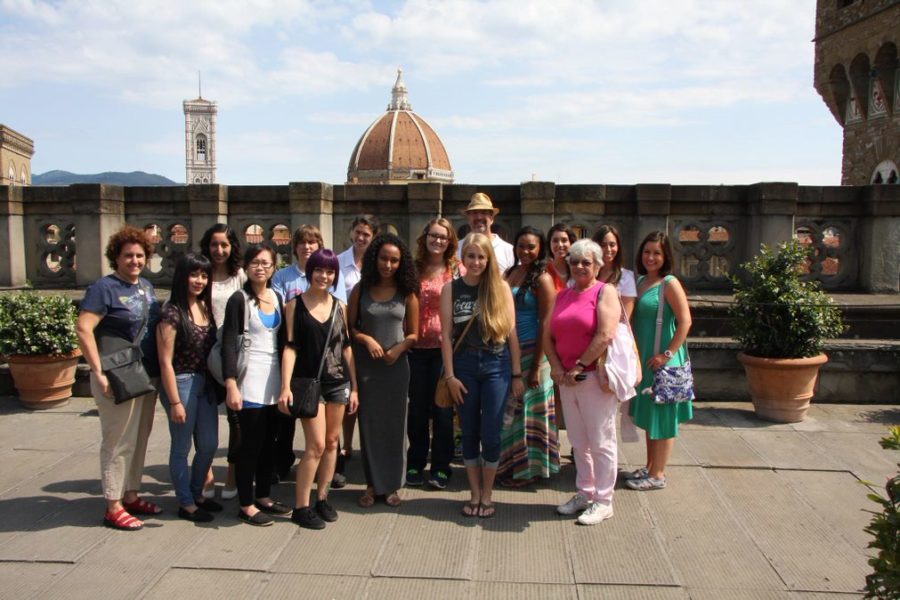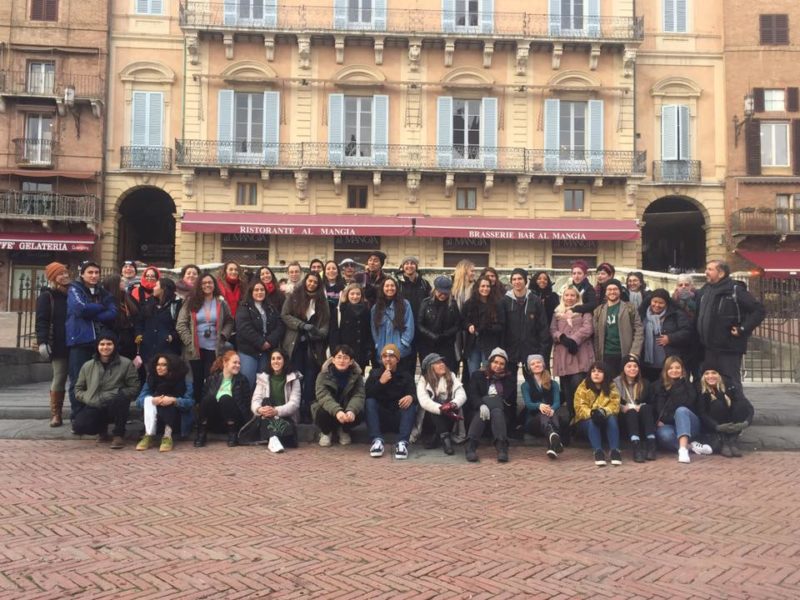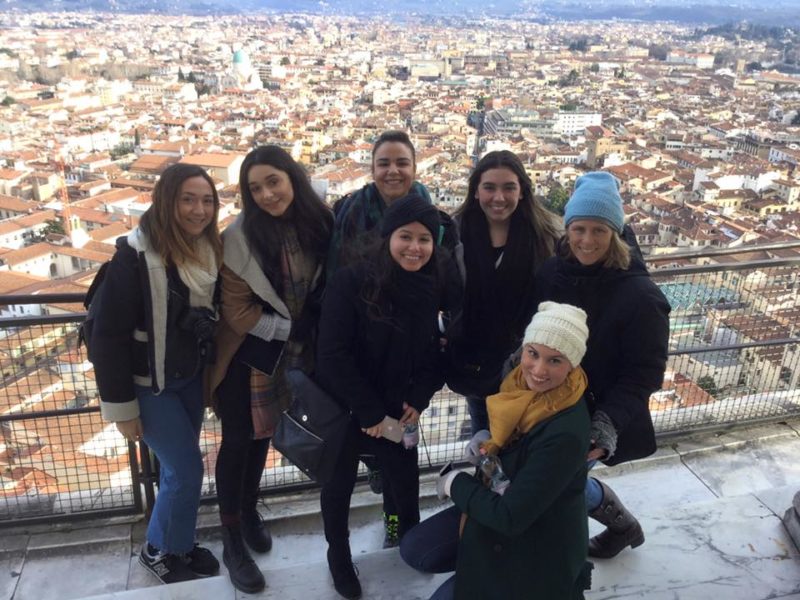
This week we’re highlighting two faculty known to us at AIFS CFL and to their Study Abroad office as the “Citrus Dream Team.”
Professors Senya Lubisich and Michael Hillman have taught together on three Citrus College programs to Florence, Italy (as well as additional programs individually or with other faculty) and really highlight the best in collaborative teaching while abroad.
Name: Senya Lubisich, Professor of History & Humanities
Name: Michael Hillman, Professor of Art, Ceramics, Art History
Did you study abroad as a student? Do you feel that it has influenced your college experience and/or your career?
Senya Lubisich: I studied in Paris, France as a student and it transformed my college experience. No other experience better honed my understanding of what I wanted to do with my education and life than the months that I spent living in Paris. I learned about myself and the ways in which I could meet and manage challenges. I learned about French culture, life, and history and was able to gain a more nuanced understanding of my own culture, life, and history. I gained deep appreciation for diversity and difference. I came to see Paris as “home” and, to this day, have a deep connection to the city and its people.
Michael Hillman: I did a “study abroad” with my sister for 1 month in Europe when I was a Freshman in high school. We traveled to 6 countries in 32 days all the while camping. The following year, with my parents in tow as chaperones did an extensive exchange living with a Danish family and then traveling with them around Europe for 21 days. When I finished my BFA in ceramics, I got my teaching credential as part of a study abroad for the Fall semester in Winchester England, where I taught art and ceramics. All of these experiences had lasting and deep influences on me and the importance of seeing cultural objects; drawings, paintings, architecture and such in situ. In context. That is the primary reason I LOVE the study abroad programs; the students see the actual works of art instead of seeing them in a book, or on a video. The art, the world, the culture comes alive with a vibrancy that you would not have otherwise
What courses have you taught abroad and where?
Senya Lubisich: I taught World History to 1500 in Florence, Italy during the summer of 2010. I taught Humanities – Renaissance to 1900 in Florence, Italy during the summer 2014, winter 2017 and winter 2019. Most recently I taught World History since 1500 in Kyoto, Japan in summer 2019.
Michael Hillman: I taught Introduction to Art during the summer sessions of 2010, 2012, and 2013 in Florence Italy, 2012. In the winter sessions 2017 and 2019 in Florence Italy I taught History of Western Art – Renaissance to Rococo and History of Western Art- Renaissance to Contemporary Art. Our program for the fall semester 2020 to Rome, Italy has been postponed but I plan to teach Humanities, Introduction to Art, Art History-Renaissance, Public Art there in a future semester.
How did your destination(s) complement your teaching?
Senya Lubisich: Oh my! The destinations have shaped my teaching – not simply complimented it. I find the opportunity and challenge to use the destination as a textbook one of the great joys in Study Abroad. I have always taught the “J-term” and only have four weeks to introduce students to the destination through the course content. I work diligently to design the excursions, lessons, and assessments so that students are actively using the destination as a laboratory for the course. The rich resources of local museums are essentially “field studies” for the students. They are able to view and experience artifacts that are directly related to the course content. Teaching world history in Japan allowed the opportunity to explore the world’s history through the lens of the Pacific Rim. Teaching Humanities in Florence allows students to walk around the creations of Michelangelo and Botticelli rather than to view two-dimensional images on a screen. I work with the mantra that I did not bring students to a foreign country just to sit in a classroom like the one they left in the United States. Active learning in the destination is always my goal.
Michael Hillman: When you flip through any art history books, there are always a few images that are ALWAYS included. The David by Michelangelo, The Vatican, Botticelli, Birth of Venus etc. When teaching in Italy, not only do the students learn about these objects, they are face-to-face with them. Seeing the brush strokes of the artist, the scratches of the tools on the marble, and the scale and enormity of the architecture…this is crucial to an Arts education. Also, seeing the culture in which the objects were created enhances the learning.

What motivated you to bring students abroad?
Senya Lubisich: Certainly, my own experience with study abroad is influential. However, travel is a fundamental value for me and my family. I believe that experiencing and working to understand the diverse cultures and traditions of the world is essential. I believe that most students have a curiosity and interest in travel and that, as an instructor, I can help create opportunity and excitement to act on their desire. A colleague and frequent study abroad partner of mine often states, “You can’t teach experience.” However, one of the great delights about taking students abroad is that you can facilitate that experience. My goal is for every student to learn more about their capabilities and to stretch their perspectives. I enjoy the relationships that I build with students through study abroad and I delight in seeing students “catch the travel bug” as a result of studying abroad.
Michael Hillman: Having traveled abroad in High School and College, I know how enriching these experiences were to me, and I wanted to share them with my students.
What is your favorite part about leading students on a customized study abroad program?
Senya Lubisich: I have only every had positive experiences working with AIFS. When my first-born graduated from high school and wanted to take a gap year, there was no question that we would look anywhere other than AIFS. In my own experiences, the resources and relationships that AIFS brings to bear in their programs are invaluable. To a certain degree, the AIFS staff have been my teaching “genie.” I ask for an excursion or a cultural experience and they help me bring it to fruition. I love the knowledge and suggestions that truly allow me to activate the destination for my students. I also am greatly relieved to have well organized meeting rooms, resources, subject matter experts/guides, and assistance when necessary. I am ever grateful for the “can-do” attitude that I encounter in the faculty-led programs. I have only ever been offered wonderful solutions to my queries and I know that the students, ultimately, are the beneficiaries.
Michael Hillman: Watching in awe and excitement as they step into the Academia to see the David Michelangelo, hiking up to the top of the Duomo in Firenze to see the city below, and feeling that they are living in the Renaissance. Of course, for many tasting real gelato and panna cotta for the first time and wondering why we don’t have this in the US. And, the comments when the trip is over, sometimes years later, to hear how it has changed their lives in so many, many ways.
A colleague and frequent study abroad partner of mine often states, “You can’t teach experience.” However, one of the great delights about taking students abroad is that you can facilitate that experience.
~Senya Lubisich
Describe a favorite moment or memory of your program:
Senya Lubisich: As part of our stay in Florence, students visit the Duomo and climb the stairs to the panoramic view on top. We had a student who was terrified of heights and struggled with the decision to join the group or to stay on the ground. Her roommate and I, hooked arms with her, told her to close her eyes, and guided her to the top of the Duomo. At certain moments, like when you step out among the frescoes of the Dome, we encouraged her to open her eyes. When we got to the top, we found a bench and sat with her. Her sense of exhilaration, accomplishment, and delight was contagious. When we were talking about the architectural feat of the Duomo later in class, she talked about the awe she felt for having walked among the bricks that created the inner and outer shell. It was a part of our trip and huge experience for her.
Michael Hillman: We were in Firenze, we did not have a planned trip to Venice, so I organized this myself and asked how many would like to go. 58 STUDENTS! As the trip got closer, we were told it would be 100% rain and it was going to be miserable walking along the canals in Venice for an entire day in the rain…..but…..when we arrived it was gloriously sunny! I walked the students across the town to the Guggenheim and saw one of the most impressive collections of art in the world. We walked around St. Mark’s square and then I set them free to explore the rest of the day. 58 students alone, were to find their way back to the train station by 7pm. I was worried. The rest of the day was magnificent. As we got closer to the time of departure, we started to see the students appear, 2 at a time, groups of 4 or 6, etc. Low and behold 58 students had made it back in time. BUT, then it happened. On this beautiful sunny day, as the sun was setting over the grand canal, it started to SNOW!!!! Most of these California natives had never seen the snow, let alone in ITALY. Within minutes the canals, gondolas, domes and cupolas of Venice were a beautiful snowy white. As we watched in delight, one of the students sat down and started to play on a piano and amazing piece of music. Our senses were stimulated to overload. Now, that was a good day.

Was there anything you found challenging about the experience?
Senya Lubisich: In the decade I have done study abroad programs, the needs of students have changed dramatically. I have a much deeper understanding of the mental health issues that students face and that often materialize as part of the study abroad experience. Depression and anxiety occupy a different level of my attention now than they did when I first started as a study abroad instructor. Fortunately, AIFS also keeps pace with the changing needs and demands and so there is good support. However, programs run better when there is good collaboration between faculty, staff, and students.
Michael Hillman: NEVER! Any challenge became a problem-solving situation for me and the students…. like losing half the group in Frankfurt and staying the night in Germany. Many students said they really enjoyed that evening in the hotel…. they got to rest up, eat well, etc. Although they all looked panicked and scared, one student later remarked “Wow Hillman, you stayed as cool as a cucumber.” Traveling is always a bit of a challenge; you must learn to go with the flow and make the best of it.
Any advice for faculty thinking of leading a customized program abroad?
Senya Lubisich: Go! Re-imagine your content and re-invigorate your teaching. We can teach in the same classrooms, with the same content, and changing groups of students or we can transform the classroom, the content, and the students. Study abroad is engaging for students and for faculty. The support that AIFS provides is substantial and they will meet you at your comfort level. However, just as I would say to students, broaden your experience teaching. You and your content will come back enriched.
Michael Hillman: It will certainly be one of the highlights of their career. JUST DO IT. The AIFS staff in Florence are there to help you at all times and guide you through the journey. Don’t let the thought of logistics of housing, food, or airline travel dampen your spirit to travel and teach abroad.
Any advice for students thinking of studying abroad?
Senya Lubisich: GO! Study abroad is a rare moment in your life when you can apply for funding and scholarships to travel. You will come back with stronger academic skills, greater competency, and a more robust resume. You will also come back with experiences and memories that you will carry for the rest of your life. I have never heard anyone say that they regretted doing study abroad. I have often heard people say that they regretted NOT doing study abroad. Don’t let the window close on a trans-formative experience. Put the programs on your radar and start looking for funding now. There are creative ways to leverage funding that make the programs affordable and manageable. You will be so glad that you made the effort.
Michael Hillman: Be prepared to have more culture shock when you return home. Try to study up on the culture, the language, the traditions of the place you are traveling and try your best to fit in, assimilate.

Has your experience teaching abroad changed the way you teach back on campus?
Senya Lubisich: I am certain that every student who enrolls in my classes leaves knowing how important travel is to me. Students regularly seek me out to ask about travel and study abroad. Just as I enrich my courses abroad with destination specific content, I am able to bring that back to my classes on campus. I encourage students to “travel” at home and to learn about the places that attract tourists here.
Michael Hillman: My lectures are much more dynamic having seen most of the works of art and architecture in person. Each time I talk or lecture about something we studied in Italy, I am taken back in my mind. FANTASTIC. I include my photos and pictures in lectures to make it a more humanizing experience for the students.
What is the best part of collaborating with a colleague on a customized, faculty-led study abroad program?
Senya Lubisich: Mike Hillman and I refer to ourselves as the Florence Dream Team. In the decade of leading study abroad programs, Mike and I have had the chance to work together multiple times. Over the years, the courses that we teach have changed but our collaboration has remained intact and strong. We coordinate our syllabi, work together to select excursions and museum visits, and strive to engage the students in our respective classes in the collaboration of exploring course content in the living laboratory of the city. We learn from each other, our students learn the different perspectives that disciplines bring to the field, and each trip improves upon the previous. I believe that our professional engagement is a strong example to students and creates a respect for learning in a foreign city in which all members of the program are responsible to support academic goals.
Michael Hillman: I think the best part is that we both know our subject matter inside out. And, having two different faculty members approaching the same topic, subject matter, from different angles, the students get a much richer and or diverse take on the topic or subject matter. Also, it seems that we can finish each other’s sentences or add on, so it again gives us a more in-depth curriculum. I might be talking about the formal elements of art while at the Uffizi looking at the Botticelli Birth of Venus, and then Senya would chime in about the historical and sociological aspects of what was happening in the culture at the time. With us, preplanning the curriculum together and plotting out the days and weeks, visits and topics, it feels like the students aren’t jumping around from one topic to another depending on what class they are in….again, feels logical across the spectrum of courses. When one of us is feeling tired, or off, there is the other person to shine. I think it is also good to have a male/female co-teaching aspect, as some students feel more inclined to share or ask for assistance from one or the other.
Where would you like to visit next, either for vacation or for a faculty-led program?
Senya Lubisich: Prior to the pandemic, our family had planned a trip to New Zealand. When we are not doing study abroad, we enjoy trekking. I’ve not traveled in China or India and so those are places am I eager to go. I hope to take students to Paris in the not-too distant future. However, to be perfectly honest, I will be happy to have my backpack on my pack, passport in hand, and any foreign destination in sight.
Michael Hillman: Spain